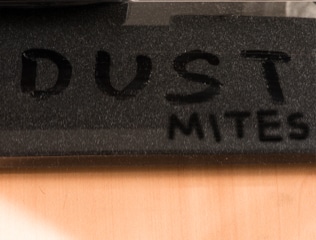Allergy symptoms from dust mites can be frustrating. Watery eyes, constant sneezing, congestion, and asthma symptoms can interrupt your daily life and make you miserable. While most allergy causes cannot be eradicated completely, you can still do several things to reduce their severity.
What are Dust Mites?
According to HealthLine, Dust Mites are extremely tiny bugs that belong to the spider family. They are the most common indoor allergens that cause annoying allergy flare-ups. These microscopic bugs live in mattresses, pillows, carpets, drapery, stuffed animals, and all kinds of upholstery. Fiber threads and dead skin cells attract dust mites, so they thrive in warm temperatures (above 70 degrees) with high humidity (75 to 80 percent).
In these environments, they multiply rapidly. A 3-square-inch mattress, pillow, or carpet may be home to over 100,000 mites, with each fully grown female laying 60-100 eggs in just a few short weeks. Fortunately, these microscopic bugs do not bite, sting, or burrow into your skin. However, their fecal matter and body parts are easily inhaled and can cause severe allergies.
Allergies Symptoms
People who are allergic to dust mites typically experience the following symptoms:
- Nasal Congestion
- Runny Nose
- Sneezing
- Watery Eyes
- Itchy Skin when lying in dusty areas
- Asthma Symptoms
Those who are allergic will react negatively with the proteins in the bodies and feces of mites. Additionally, dust mites are a huge factor in the development of asthma in children, which is why it is essential to keep their population to a minimum. Fortunately, while dust mites never go away completely, there are a few steps you can take to minimize their populace.
Reducing the Presence of Dust Mites
You can help reduce the population of dust mites by following these easy steps:
- Remove old carpets, rugs, drapes, upholstered furniture, and stuffed animals.
- Enclose all mattresses and pillows with dust-mite-proof covers.
- Wash sheets in hot water (140º F or above) at least once per week.
- Use a HEPA filter-equipped vacuum.
- Reduce the indoor temperature to less than 70º F with less than 50% humidity (you can use a dehumidifier).
Treating Dust Mite Allergies
Common allergy medications, such as oral antihistamines, steroid nasal sprays, and saline nose washes, are all effective treatments for dust mite allergy symptoms. Furthermore, allergy immunotherapy shots have decreased a person’s allergy sensitivity and response.
If you are struggling with your symptoms and believe you may have a dust mite allergy, contact McGovern Allergy at mcgovernallergy.com or (713) 661-1444.

